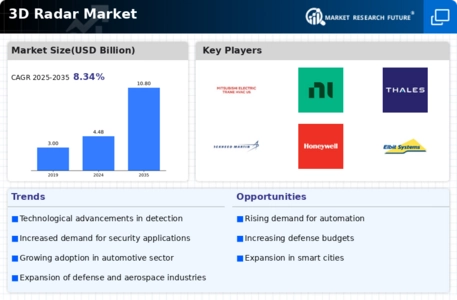Market Share
Introduction: Navigating the Competitive Landscape of 3D Radar Technology
The 3D Radar market is experiencing a transformative phase driven by rapid technology adoption, evolving regulatory frameworks, and heightened consumer expectations for precision and safety. Key players, including OEMs, IT integrators, and infrastructure providers, are fiercely competing for market leadership by leveraging advanced capabilities such as AI-based analytics and IoT integration. OEMs are focusing on enhancing radar accuracy and reliability, while IT integrators are emphasizing seamless data interoperability. Emerging disruptors, particularly AI startups, are introducing innovative solutions that automate data processing and enhance operational efficiency, thereby reshaping competitive dynamics. As regional markets expand, particularly in North America and Asia-Pacific, strategic deployment trends are leaning towards green infrastructure and biometrics, positioning companies to capitalize on sustainability initiatives and regulatory compliance. The interplay of these technology-driven differentiators will be crucial for stakeholders aiming to secure a competitive edge in the evolving 3D Radar landscape.
Competitive Positioning
Full-Suite Integrators
These vendors offer comprehensive solutions integrating 3D radar technology with broader systems for defense and industrial applications.
| Vendor | Competitive Edge | Solution Focus | Regional Focus |
|---|---|---|---|
| Lockheed Martin | Strong defense sector expertise | Defense and aerospace systems | Global |
| Raytheon Technologies | Advanced sensor technology | Defense and security solutions | Global |
| Northrop Grumman | Innovative radar solutions | Aerospace and defense | Global |
| Boeing | Integrated aerospace capabilities | Aerospace and defense systems | Global |
Specialized Technology Vendors
These companies focus on niche 3D radar technologies, providing specialized solutions for various applications.
| Vendor | Competitive Edge | Solution Focus | Regional Focus |
|---|---|---|---|
| Mitsubishi Electric | Innovative radar technology | Industrial and automotive applications | Asia-Pacific |
| National Instruments | Flexible measurement solutions | Test and measurement systems | Global |
| Texas Instruments | Advanced semiconductor technology | Embedded systems and radar solutions | Global |
| Kongsberg Gruppen | Strong maritime focus | Maritime and defense systems | Europe and North America |
| Leonardo S.p.A. | Integrated defense solutions | Aerospace and defense technologies | Europe and Middle East |
Infrastructure & Equipment Providers
These vendors supply the necessary infrastructure and equipment to support 3D radar systems.
| Vendor | Competitive Edge | Solution Focus | Regional Focus |
|---|---|---|---|
| Fujitsu | Robust IT infrastructure | IT and communication systems | Asia-Pacific |
| Thales Group | Comprehensive security solutions | Defense and transportation systems | Global |
| Honeywell | Diverse technology portfolio | Aerospace and industrial solutions | Global |
| Elbit Systems | Advanced defense technologies | Defense and homeland security | Global |
| Israel Aerospace Industries | Innovative aerospace solutions | Aerospace and defense systems | Global |
| L3Harris Technologies | Integrated communication systems | Defense and commercial solutions | Global |
Emerging Players & Regional Champions
- Vayavya Labs (India): Specializes in advanced 3D radar signal processing solutions for automotive applications, recently partnered with a major automotive manufacturer for integration into next-gen vehicles, challenging established vendors by offering cost-effective and innovative solutions tailored for the Indian market.
- AeroVironment (USA): Focuses on small unmanned aerial systems (UAS) equipped with 3D radar technology for surveillance and reconnaissance, recently secured a contract with the U.S. Department of Defense, complementing established defense contractors by providing agile and adaptable radar solutions.
- Rohde & Schwarz (Germany): Offers high-performance 3D radar systems for air traffic control and maritime applications, recently implemented a system for a European airport, enhancing competition with traditional radar providers through superior technology and customer service.
Regional Trends: In 2023, there is a notable increase in the adoption of 3D radar technology across Asia-Pacific, driven by advancements in automotive and defense sectors. Europe continues to lead in regulatory compliance and integration of 3D radar in air traffic management, while North America sees a surge in military applications. Emerging players are focusing on niche markets and innovative solutions, often leveraging partnerships to enhance their market presence against established vendors.
Collaborations & M&A Movements
- Leonardo S.p.A. and Thales Group entered into a partnership to develop advanced 3D radar systems for defense applications, aiming to enhance their competitive positioning in the military sector amidst increasing global defense spending.
- Northrop Grumman acquired the radar technology division of Orbital ATK to strengthen its portfolio in the 3D radar market, positioning itself as a leader in aerospace and defense technologies.
- Raytheon Technologies and BAE Systems collaborated to integrate their 3D radar technologies for improved surveillance capabilities, responding to the growing demand for advanced radar solutions in both civilian and military applications.
Competitive Summary Table
| Capability | Leading Players | Remarks |
|---|---|---|
| Biometric Self-Boarding | Thales, Gemalto | Thales has implemented biometric self-boarding solutions at major airports, enhancing passenger flow and reducing wait times. Gemalto's technology integrates seamlessly with existing systems, showcasing a strong adoption rate in European airports. |
| AI-Powered Ops Mgmt | Siemens, Honeywell | Siemens leverages AI for predictive maintenance in radar systems, improving operational efficiency. Honeywell's AI solutions have been adopted in various airports, optimizing resource allocation and enhancing safety protocols. |
| Border Control | Raytheon, Northrop Grumman | Raytheon's border control systems utilize advanced 3D radar technology for real-time surveillance, significantly improving border security. Northrop Grumman's solutions are noted for their integration with existing defense systems, enhancing situational awareness. |
| Sustainability | Lockheed Martin, BAE Systems | Lockheed Martin focuses on developing energy-efficient radar systems, reducing environmental impact. BAE Systems has implemented sustainable practices in their manufacturing processes, gaining recognition for their commitment to eco-friendly technologies. |
| Passenger Experience | Cisco, SITA | Cisco's 3D radar technology enhances passenger experience through improved navigation and real-time information sharing. SITA's solutions have been adopted in various airports, providing seamless connectivity and enhancing overall passenger satisfaction. |
Conclusion: Navigating the 3D Radar Market Landscape
The 3D Radar market in 2023 is characterized by intense competitive dynamics and significant fragmentation, with both legacy and emerging players vying for market share. Regional trends indicate a growing demand for advanced radar solutions in North America and Europe, while Asia-Pacific is rapidly adopting these technologies. Vendors are strategically positioning themselves by leveraging capabilities in AI, automation, and sustainability to enhance product offerings and operational efficiency. As the market evolves, flexibility in adapting to customer needs and technological advancements will be crucial for leadership. Companies that prioritize these capabilities will not only differentiate themselves but also secure a competitive edge in this rapidly changing landscape.

















Leave a Comment